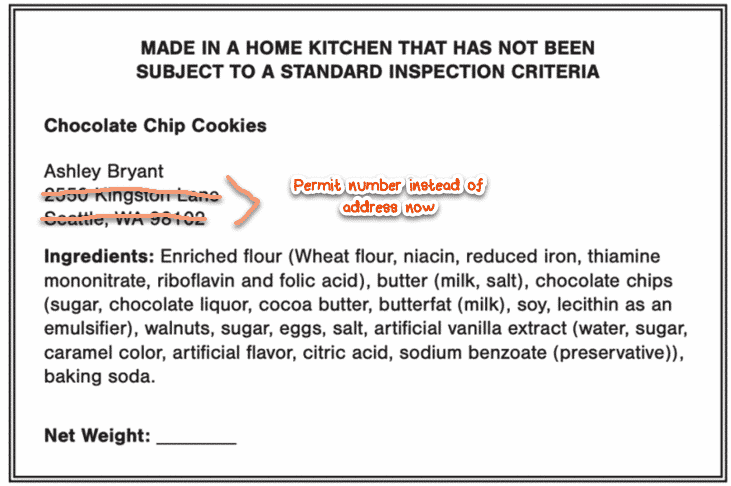Washington cottage food laws are intentionally complex and tedious. Still, very doable! It ranks as the worst state to get started. One can only view this as an attempt by the lawmakers to protect retail food businesses from competition.
How do you eat an elephant? One bite at a time!
Just like eating an elephant, you can get get through this process and begin your profitable cottage food business – one step at a time. Under the guise of encouraging cottage food owners to expand into a full-fledged retail shop / business – has an annual cap on the income you’re allowed to make.
NOTE: Although against the intent and purposes of the limitations, many cottage food vendors find it near impossible to grow beyond cottage food being limited to $35,000 annually, so some don’t report accurately while saving until their income reaches something more reasonable – being able to open a licensed commercial kitchen with no limitations. 😉
IMPORTANT: Before you run off thinking it’s too hard or can’t be done… here’s a current list of Washington State Cottage Food Entrepreneurs who are making it happen!
Table of Contents
HOW TO START YOUR COTTAGE FOOD BUSINESS IN WASHINGTON – LICENSING

To start your cottage food business, follow the steps below. DON’T get discouraged and you’ll soon be amongst a small group of successful cottage food entrepreneurs.
Over 10 years ago I interviewed a lady on our old podcast who had started making cupcakes at home in Washington. She went on to open a bakery not long after our interview due to her incredible business growth right from home.
The easiest way to go through the following items is to pull up Washington’s Cottage Food Law page and scroll down to the BEFORE YOU APPLY section.
Afterwards, open up the Cottage Food application and read through it. Each section has links to examples of what they require.
STEPS TO START
- Pick foods to offer from the “allowed” food types listed below.
- If you’re on well water – get your water tested – click here to contact your local Health Dept
- Get a Washington Food Worker card
- Get a Business License Here
- Draw up a floor plan
- Outline of your packaging and labeling process
- List of equipment to be used and sanitizing process
- Give a schedule of your planned processing dates and sales venues
- If you have children under 6 and/or pets – provide plan
- Submit application and pay fee (must be renewed every two years)
- Start baking/cooking, marketing and selling
WASHINGTON COTTAGE FOOD LAWS – Foods That Are Allowed
Please reference Allowable Products under the Cottage Food Rule (WAC 16-149-120). The list below is not all inclusive but includes most types of approved cottage food products:
- Low risk baked or fried products that are cooked in an oven, on a stove top, or in an electric device designed for cooking food, including:
- Loaf breads, rolls, biscuits, quick breads and muffins;
- Cakes including celebration cakes such as birthday, anniversary, and wedding cakes:
- Sweet breads made with fresh fruit or vegetables are allowed as long as the fruit or vegetables are incorporated into the batter and oven-baked.
- All frostings or glazes must have a cook step or be made with ingredients (such as a large amount of sugar) that when combined are stable at room temperature and won’t spoil.
- Pastries and scones;
- Cookies and bars;
- Crackers;
- Cereals, trail mixes and granola;
- Pies, except custard style pies, pies with fresh fruit that are unbaked or pies that require refrigeration after baking;
- Nuts and nut mixes;
- Snack mixes; and
- Donuts, tortillas, pizelles, krumkake, kale chips and similar products.
- Candies cooked on a stove top or in a microwave (temperature monitoring with candy thermometer is required).
- Molded candies and chocolates;
- Products dipped or coated with candy or chocolate coatings;
- Fudge or Fudge-like candies;
- Caramels;
- Nut Brittles; and
- Taffy and marshmallow-like candies;
- Jams, jellies, preserves and fruit butters (made according to the standards set by FDA in 21 C.F.R 150.)
- Recombining or packaging of dry herbs, seasoning and mixtures that are obtained from approved sources.
- Including teas, bread mixes, soup mixes and dip mixes
- Small batch roasted coffee beans
- The roaster cannot be commercial size and generally must fit on a kitchen countertop
If your food item is in question and not listed above, you can reach out and see if your food would be considered non-TCS / non-potentially hazardous:
Washington Agriculture Department
601-576-8090
Real Life Cottage Food Entrepreneurs and Opportunities
- Cakes – teacher turns kitchen into bakery
- Doughnuts – cottage mini donut vendor
- Fruit jams and jellies – See Additional Requirements Here
- Kettle corn – real kettle corn vendors from home
- Popcorn (plain and flavored) – see a real home vendor here
- Talk and Join hundreds of others here: VendorsUnited.com
WASHINGTON COTTAGE FOOD LAWS – PROHIBITED FOODS
Please reference Prohibited Products (WAC 16-149-130). The list below is not all inclusive but includes most types of prohibited cottage food products:
- This section lists Cottage Food products that are not allowable. Although not inclusive, it lists most types of unapproved products:
- Fresh or dried meat or meat products including jerky;
- Fresh or dried poultry or poultry products;
- Canned fruits, vegetables, vegetable butters, salsas, etc.;
- Fish or shellfish products;
- Products made with meat, poultry or fish products;
- Canned pickled products such as corn relish, pickles, sauerkraut;
- Raw seed sprouts;
- Bakery goods which require any type of refrigeration such as cream, custard or meringue pies and cakes or pastries with cream or cream cheese fillings, fresh fruit fillings or garnishes, glazes or frostings with low sugar content, cream, or uncooked eggs;
- Milk and dairy products including hard, soft and cottage cheeses and yogurt;
- Cut fresh fruits or vegetables;
- Food products made from fresh fruits or vegetables;
- Garlic in oil mixtures;
- Juices made from fresh fruits or vegetables;
- Ice or ice products;
- Barbeque sauces, ketchups, or mustards;
- Focaccia-style breads with vegetables or cheeses; and
- Beverages
- Food products not for human consumption such as dog treats
- For information regarding Pet Food, contact [email protected] or (360) 902-1844
WASHINGTON ANNUAL SALES LIMITS
Most states set a cap on what you’re allowed to make annually.
This is usually put in place to push you towards opening a full-fledged retail business while at the same time letting you start from home.
Washington has an annual sales limit for cottage food entrepreneurs at $35,000.
Colorado encourages its Cottage Food Entrepreneurs to grow beyond cottage food and provides help. I have provided it here for a resource as you grow your business and wish to expand.

ACIDITY LEVELS AND TESTING
Most states determine if a food is non-potentially hazardous by the acidity level found in the food. The higher the acidity, the more stable at a range of temps, that food product is.
For example: milk is low acidity and requires temperature controls.
The acidity of foods is measured by pH.
• The range of pH is commonly considered to extend from zero to 14. A pH value of 7 is neutral because pure water has a pH value of exactly 7.
Values less than 7 are considered acidic, while those greater than 7 are considered basic or alkaline.
• All fruits are acidic foods and are usually tart and sour. Ex: tomato, lemon, peach, apple, etc.
• The FDA rule for acidic foods states that a food must have a pH below 4.6 to be sold as a minimally processed food
• The reason for this is bacteria does not grow at this level of acidity.
• The exclusion shall not be construed as allowing the sale of low acid foods (pH > 4.6) i
hermetically sealed containers (i.e. home-canned green beans, peas, etc.) when such
food is not prepared in a permitted establishment.
TESTING
Some states require testing if the pH level is unknown.
For many food products, the pH level is already known. You can test for pH yourself using a pH spear tester. (make sure it is made for food and has a long spear tip).
Oklahoma State University shares an awesome guide for selecting the correct tester for foods and liquids which includes tips and tricks for operation and maintenance. Get The Guide Here.
WASHINGTON COTTAGE FOOD LAWS LABELING REQUIREMENTS
- Submit the actual label that will be attached to your product.
- Your label must contain the following:
- Labels must have the statement in at least 11-point font: “Made in a home kitchen that has not been subject to standard inspection criteria.”
- Name of the business and license number
- The name of the product
- All of the ingredients used in the product, listed in order by weight (ounces, grams) from largest to smallest.
- “Net weight” or “net volume” of the product
- Allergen information
- Labels must have the statement in at least 11-point font: “Made in a home kitchen that has not been subject to standard inspection criteria.”
COTTAGE FOOD LABEL EXAMPLE
Below is an example of what Washington requires on their labels.

Using VistaPrint.com or similar – you can quickly create professional labels that not only serve to meet the state cottage food guidelines but also serve for marketing your awesome business and products.
You’ll find some fantastic examples of this from members inside VendorsUnited.com
ALLERGENS ON LABELING
The FDA lists nine (9) major food allergens. Listing any of these on your label is a smart business practice and will certainly help your customers choose a product.
- Milk
- Eggs
- Fish (e.g., bass, flounder, cod)
- Crustacean shellfish (e.g., crab, lobster, shrimp)
- Tree nuts (e.g., almonds, walnuts, pecans)
- Peanuts
- Wheat
- Soybeans
- Sesame seeds
Simply add to your label: “CONTAINS: SOYBEANS” Some go as far to announce that a certain allergen is used in the same kitchen.
Some states require you list any potential allergens and potential for any cross contamination even if the allergen is not used in the recipe.
FDA Allergen Labeling Example: Contains Wheat, Milk, Egg, and Soy
WHERE CAN I SELL MY COTTAGE FOOD PRODUCTS
Washington Cottage Food Laws – Sales Rules
All sales, including online sales, are restricted to:
Events
Farmers markets
Home
Online – Social Media is an excellent method. Discover how our VU members do this.
Roadside stands
Delivery
Pickup
COVID 19 UPDATE: Washington is allowing mail order during Covid 19
*All sales including online must remain in state and be exchanged in person. Wholesale, out of state and mail order are not allowed at this time.
Inside kitchenincome.com you can find out how many cottage food entrepreneurs are getting sales faster than they can make the food.
FOOD HANDLER TRAINING AND BEST PRACTICES
Washington requires you have a Food Worker Card, which you can get here: Washington State Food Worker Course.
Many of our VendorsUnited.com members are proud to display their food safety certificates as a way to insure their customers that they care. This helps your business.
- Short courses that provide food handling and safety certification
- Free info from the FDA – food safety
SAFE PRACTICES
Much of this may seem like common sense, but even if you already know, it’s a good idea to remind yourself with a list of things that can prevent you from missing something small.
And if for no other reason… CYA! CYA = Cover Your A#%
CLEAN WORK AREA / WORK SPACE / SANITIZATION
Providing safe to eat foods from your kitchen – starts in your kitchen.
Keep your area clean and sanitized to avoid cross contamination and to insure you provide your customers and clients with the safest and best foods they can get.
The following are some “common” sense things you can do to insure the best environment for preparing foods to sell:
- Keep all equipment and surface areas clean and sanitized
- Make sure window and door screens are bug proof with no gaps
- Keep ingredients separate to prevent cross contamination / e.g. raw eggs near flour
- No pets in work area and preferably none in the home
- Allow no-one with a cold, sniffles or sick in kitchen while preparing foods
- Wipe down walls and clean floors daily
- Use good lighting to avoid missing unclean areas
- Keep window and door screens in good repair to keep insects out
- Wash hands frequently while working and use food grade gloves for extra safety
- Keep areas of food storage and equipment storage clean and sanitized
RECORD KEEPING
Why keep these types of records? Let’s say the inspector calls you and says they got a report that your banana bread, someone purchased, made them sick.
You’ll be able to show that you didn’t even make banana bread that week and that the person who reported you, bought that 4 weeks ago and you weren’t even the one that sold it to him.
This does not need to be complicated. I love my yellow legal pads and they make an inexpensive tool for keeping up with the following:
- The recipes you use including ingredients
- The process you use to prepare that specific recipe: (can be just like recipe instructions)
- Date made (can be coded for your own use only if your state doesn’t require the production date) e.g. Made 12.22.29 = 292212
- Date sold (you can have a batch code to help track a certain batch) Simply write down date you sold an item
- Location sold is another great piece of information to keep track of
- Sales receipts are something great to keep for a couple of reasons and over at KitchenIncome.com I dive into the best practices, best systems and best methods for tracking, managing, selling and shipping.
COTTAGE FOOD lIABILITY INSURANCE
We live in a society that likes to sue. I can sue you for wearing that color shirt. No kidding!
Of course I probably won’t win, but at the very least, it’s gonna cause you stress and some costs.
Liability insurance is a MUST.
It can be expensive – but several years ago, I found FLIP and by far, they gave me the most protection (coverage) and allow you to run your cottage food business without fear of being sued.
WHY? Because they provide the lawyers. And their lawyers… they are good!
Of course you should price shop around with your local agent or a national brand company, but rest assured, I’ve done all the legwork for you.
Alternatively, some folks opt to get bonded. You’ve heard the saying before: “licensed and bonded”.
A bond is usually provided from an insurance bonding company or your own insurance company. My first time, I got a bond at State Farm.
A bond is expensive comparatively but is less out of pocket in the beginning. Of course, it’s way, way less insurance / coverage too.
A $10,000 bond may cost $50 annually while a $2,000,000.00 liability policy may cost a few hundred a year.
No matter what you decide… knowing you’re insured against frivolous lawsuits is worth every penny.
WASHINGTON COTTAGE FOOD LAWS IMPORTANT LINKS
- Cottage Food Step by Step (start here)
- Cottage Food License Application Packet
- City Business Licensing Fee Schedule
- List of Current Cottage Food Entrepreneurs in Washington
- Link to most recent code with updates
WASHINGTON COTTAGE FOOD CONTACT INFO
Washington Food Safety – Cottage Food Division
PO Box 42591
Olympia, WA 98504-2591
(360) 902-1876
[email protected]
UPDATES TO WASHINGTON COTTAGE FOOD LAWS
From time to time, links, info, rules and numbers change, are updated or made obsolete.
Although I spend time daily with hundreds of vendors (many of which are cottage food businesses) – I can miss an update.
If you find a broken link or outdated state information… please let me know and I’ll send you a special thank you for helping me maintain the best site on the internet for the cottage food industry.
My goal has always been to have a central place that is absolutely free for those starting out or existing entrepreneurs who use their homes and kitchens to make real incomes.
Please send to [email protected] / or post inside the private VendorsUnited.com group.
Need more resources? Check it out HERE (Helpful Resources)
Take a peek at the best vendors on the planet, the community that rocks the food vending world: Vendors United…

Disclaimer
This information is provided to help those interested in starting a cottage food business. It is not a document made by the state government. This information is not provided as law nor should be construed as law. Always use the contact information for each state to confirm compliance and any changes.
Did we help you? Help us to share this information…
 WATCH VIDEO!
WATCH VIDEO! WATCH VIDEO!
WATCH VIDEO!